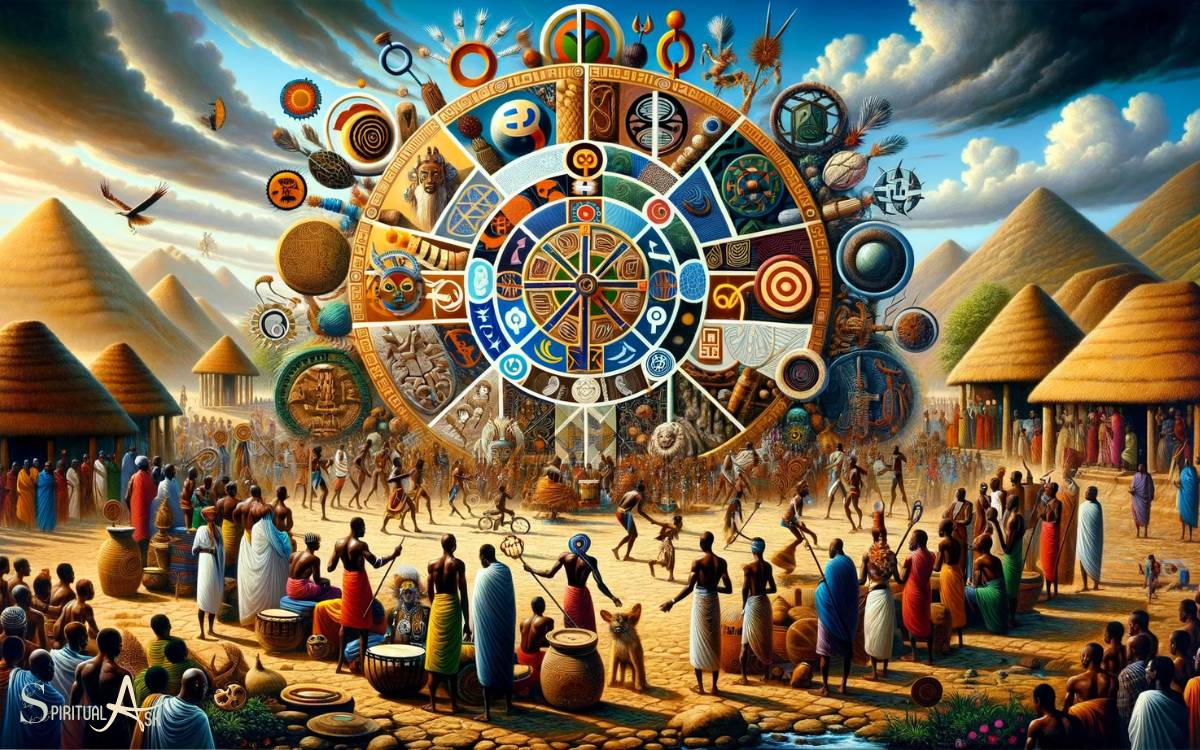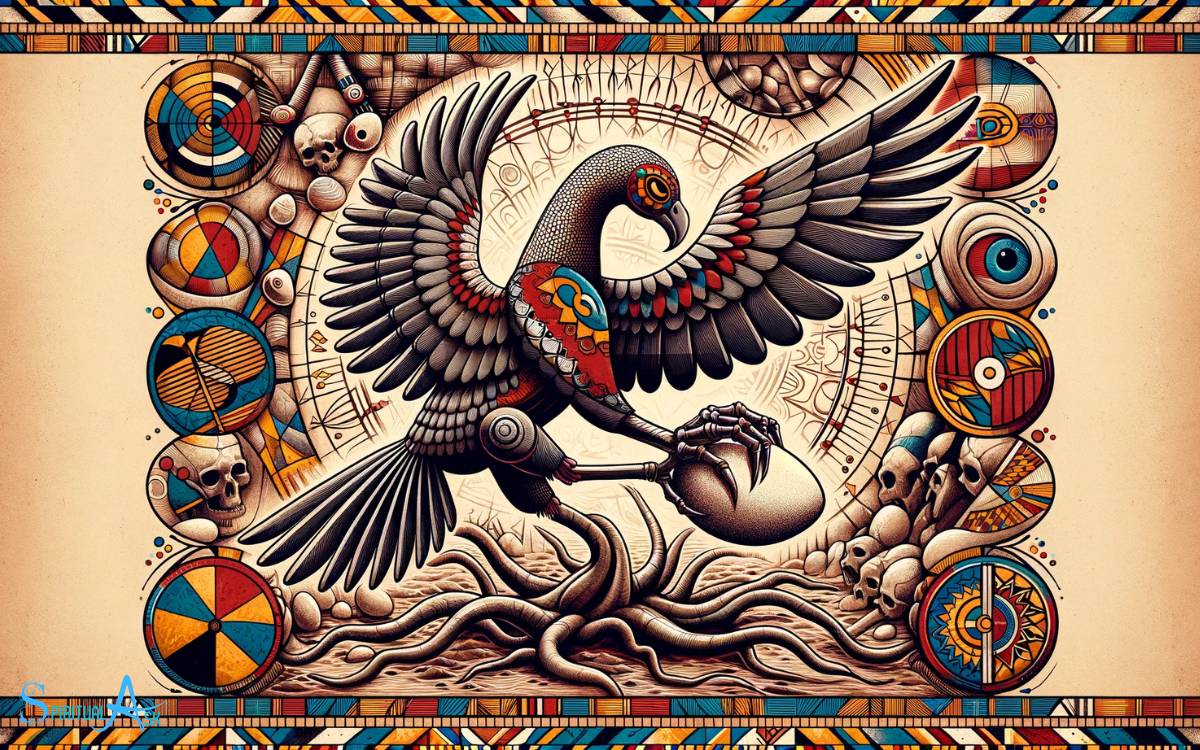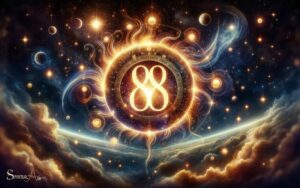Spiritual African Symbols and Meanings: Adinkra!
African symbols, known as Adinkra symbols, are found extensively in Ghana and Côte d’Ivoire within West Africa, each holding deep spiritual meanings and used to convey traditional wisdom, aspects of life or the environment.
Some widely recognized symbols include the Gye Nyame, representing the supremacy of God, and the Sankofa, symbolizing the importance of learning from the past.
Adinkra symbols originate from the Ashanti people and are often seen on fabrics, pottery, logos, and in architecture. They are not merely decorative; each symbol encapsulates complex concepts and aphorisms.
Here are a few notable symbols:
These symbols are not static; they continue to play a vital role in cultural expression and identity among African communities and the diaspora.
The intricate designs of Adinkra symbols reflect a longstanding African tradition of imparting wisdom and values through artistry, each symbol a visual distillation of philosophical thought.

Key Takeaway
Origins of African Symbols
As a researcher, I have examined the origins of African symbols to understand their historical significance and cultural evolution.

African symbols have a rich history, often dating back centuries and deeply rooted in the continent’s diverse cultures.
These symbols were used as a form of communication, conveying messages, beliefs, and traditions. They were also an integral part of rituals, ceremonies, and everyday life.
From the Adinkra symbols of the Akan people to the Nsibidi symbols of the Ejagham people, each symbol carries a unique story and meaning.
The evolution of these symbols reflects the interconnectedness of African societies and their spiritual, social, and political dynamics.
Understanding the origins of African symbols provides valuable insight into the continent’s heritage and the enduring impact of these symbols on African culture.
The exploration of the origins of African symbols sheds light on the importance of symbolism in African culture.
Importance of Symbolism in African Culture

I believe that the importance of symbolism in African culture lies in its ability to express cultural identity, carry on ritual and tradition, and serve as a tool for communication and storytelling.
Symbols are not just decorative; they hold deep meaning and connect individuals to their heritage and community.
Understanding the significance of these symbols is essential to appreciating the richness of African culture and its traditions.
Cultural Identity Through Symbols
The significance of symbolism in African culture lies in its ability to convey cultural identity through powerful visual representations.
Symbols serve as a means of communicating the values, beliefs, and history of different African communities. They provide a way to express the complex and diverse cultural identities found across the continent.
Here’s a table to illustrate the cultural diversity and symbolism in African culture:
| Symbol | Meaning |
|---|---|
| Adinkra Symbols | Represent concepts and aphorisms |
| Ankh | Symbolizes life and immortality |
| Maasai Beadwork | Reflects social and economic status |
These symbols are deeply ingrained in African societies, and understanding them is crucial to appreciating the rich cultural heritage of the continent.
This deep connection to symbolism is a fundamental aspect of African cultural identity, shaping traditions, rituals, and societal norms.
Ritual and Tradition Significance
Delving into the significance of rituals and traditions in African culture, I’ll explore the importance of symbolism in conveying deeper cultural meanings.
Rituals and traditions are integral to African societies, serving as a way to connect with ancestors, nature, and the spiritual realm.
Symbolism plays a crucial role in these practices, acting as a language through which cultural values, beliefs, and history are communicated. Each symbol holds a specific significance, often rooted in centuries-old traditions and collective experiences.
Through rituals, these symbols come to life, carrying with them the wisdom and essence of the culture. They serve as a bridge between the past and the present, fostering a sense of continuity and identity within African communities.
Understanding the symbolism within rituals and traditions is key to appreciating the richness and depth of African culture.
Communication and Storytelling Tool
Symbolism is a fundamental aspect of African culture, serving as a powerful communication and storytelling tool deeply ingrained in rituals and traditions.
The use of symbols allows for the conveyance of complex concepts and ideas, often rooted in historical and spiritual significance, in a succinct and impactful manner.
It enables the preservation of cultural heritage and facilitates the passing down of knowledge from one generation to another.
Through symbols, the rich tapestry of African traditions and beliefs is woven into the fabric of everyday life, fostering a sense of unity and shared identity within communities.
The intricate meanings behind these symbols provide a platform for storytelling, enabling the transmission of wisdom, values, and experiences. This profound connection to symbolism underscores its vital role in African culture and heritage.
The Adinkra Symbols of Ghana

Why are the Adinkra symbols of Ghana considered important in traditional African culture? The Adinkra symbols hold significant cultural and spiritual meaning for the Akan people of Ghana, representing their history, beliefs, and values.
Here are three key reasons for their importance:
- Visual Communication: Adinkra symbols serve as a visual language, conveying complex messages and proverbs through their unique designs. This visual form of communication allows for the preservation and transmission of cultural knowledge and wisdom.
- Cultural Identity: These symbols are deeply intertwined with the cultural identity of the Akan people, symbolizing their societal roles, spirituality, and interconnectedness with the natural world.
- Spiritual Significance: Adinkra symbols are often linked to spiritual beliefs and practices, representing concepts such as unity, harmony, and the enduring presence of ancestors.
Understanding the Adinkra symbols provides insight into the rich cultural tapestry of Ghana and the broader African continent.
The Ankh: Symbol of Life and Immortality

One significant symbol in African spirituality is the Ankh, representing life and immortality. The Ankh, often depicted as a cross with a loop at the top, is an ancient Egyptian symbol that embodies the concept of eternal life.
It is believed to bring blessings of health and vitality to those who wear or use it. The loop symbolizes the eternal soul, while the cross represents the material world. Together, they signify the inseparable connection between life on earth and the afterlife.
The Ankh is also associated with key deities such as Osiris and Isis, further illustrating its significance in the realm of immortality. Its enduring presence in African culture underscores the enduring belief in the continuation of life beyond the physical realm.
The Ouroboros: Symbol of Continuity and Infinity

The Ouroboros symbolizes continuity and infinity, representing the eternal cycle of life. It is an ancient emblem that depicts a cosmic serpent devouring its own tail.
This powerful image encapsulates the concept of endless renewal and the interconnectedness of all existence.
Ouroboros: Ancient Symbol Representation
As I explore the significance of the Ouroboros, I find it to be a powerful symbol of continuity and infinity in African spiritual traditions.
The Ouroboros, often depicted as a serpent or dragon eating its own tail, carries deep meanings:
- Eternal Cycle: The Ouroboros represents the eternal cycle of life, death, and rebirth. It symbolizes the continuous nature of existence and the interconnectedness of all things.
- Infinite Unity: This symbol signifies the unity of opposites and the interconnectedness of all things in the universe. It reflects the concept that life and death, creation and destruction, are inseparable and part of a continuous, infinite process.
- Wholeness and Self-Reflection: The Ouroboros is a reminder to look within oneself for growth and self-discovery. It symbolizes the journey of self-reflection and the quest for completeness.
The Ouroboros holds a profound message about the cyclical nature of existence and the interconnectedness of all things.
Ouroboros: Eternal Cycle Emblem
Continuing my exploration of the Ouroboros from the previous subtopic, I delve deeper into its representation as an eternal cycle emblem, emphasizing its significance as a symbol of continuity and infinity in African spiritual traditions.
The Ouroboros, with its serpent or dragon eating its own tail, symbolizes the eternal cycle of life, death, and rebirth.
In African spirituality, this symbol represents the interconnectedness of past, present, and future, highlighting the cyclical nature of existence and the continuity of life beyond physical death.
It reflects the belief in the eternal and infinite nature of the universe and the interconnectedness of all living beings. The Ouroboros serves as a powerful reminder of the unbroken and continuous flow of life and energy, perpetuating the cycle of existence.
This profound symbolism is deeply rooted in various African cultures, shaping their spiritual understanding of the universe. In particular, the spiritual baptist star of david holds significant meaning, representing a connection to both ancestral heritage and divine guidance. This emblem is often invoked in rituals and ceremonies, serving as a beacon of hope and a reminder of the interconnectedness of all life. Through these practices, communities reaffirm their identity and reinforce their spiritual beliefs, fostering unity and strength in the face of adversity.
As we transition into the subsequent section about ‘ouroboros: infinite cosmic serpent’, we will further explore the significance of this emblem in African spiritual beliefs.
Ouroboros: Infinite Cosmic Serpent
Now, I delve deeper into the symbolism of the Ouroboros as an infinite cosmic serpent, emphasizing its significance as a representation of continuity and infinity in African spiritual traditions.
Eternal Cycle:
- The Ouroboros, depicted as a serpent or dragon swallowing its own tail, symbolizes the eternal cycle of life, death, and rebirth.
- In African spirituality, this represents the continuous flow of energy and the interconnectedness of all existence.
Unity and Wholeness:
- The Ouroboros also embodies the concept of unity and wholeness, reflecting the interconnected nature of the universe and the balance between opposing forces.
- This symbolizes the harmony and equilibrium within the cosmos, a fundamental belief in many African spiritual practices.
Infinite Potential:
- As a symbol of infinity, the Ouroboros conveys the idea of infinite potential and the cyclical nature of existence.
- It represents the never-ending cycle of creation, destruction, and recreation, underscoring the timeless and boundless nature of the cosmos in African spiritual beliefs.
The Djed: Symbol of Stability and Endurance

I have come across a fascinating spiritual symbol in African culture known as the Djed, representing stability and endurance. The Djed is often depicted as a column with a broad base and capital, resembling the form of a tree trunk.
It is believed to embody the stability and enduring nature of the ancient Egyptian god Osiris. The symbol is associated with the concept of regeneration, as Osiris was also connected with the afterlife and rebirth.
The Djed represents the enduring strength and resilience that are essential for navigating life’s challenges. Its significance in African spirituality teaches us about the value of stability and the endurance required to overcome obstacles.
The Eye of Horus: Symbol of Protection and Healing

One significant symbol in African spirituality is the Eye of Horus, which symbolizes protection and healing. This ancient Egyptian symbol is believed to hold powerful protective qualities and the ability to bring about healing.
The Eye of Horus is also associated with wisdom, intuition, and the ability to see beyond the physical world. Its significance extends beyond its representation of the falcon god Horus and embodies the ideals of health, safety, and inner sight.
The Eye of Horus represents:
- Protection: It is believed to ward off negative energy and provide a shield against harm.
- Healing: The symbol is associated with restoration and the alleviation of physical and spiritual ailments.
- Insight: It is thought to bestow wisdom and the capacity to perceive truth and reality.
The Sankofa: Symbol of Learning From the Past

Continuing from the previous subtopic, the Sankofa symbolizes the importance of learning from the past in African spirituality. The symbol features a bird with its head turned backwards, taking an egg off its back.
This represents the idea of reflecting on the past to build a successful future. In African culture, the Sankofa encourages individuals to draw wisdom from their history and experiences.
It emphasizes the significance of understanding and acknowledging one’s roots, as well as using that knowledge to progress and grow.
This symbol serves as a reminder that we should not forget where we come from, and that our past can provide valuable lessons for the present and future. It encourages us to learn from our mistakes, embrace our heritage, and strive for personal and collective advancement.
Conclusion
African symbols hold deep spiritual and cultural significance, representing concepts like life, continuity, stability, and learning from the past.
Did you know that there are over 50 Adinkra symbols in Ghana, each with its own unique meaning?
These symbols continue to be an important part of African heritage and are widely recognized and celebrated around the world.






